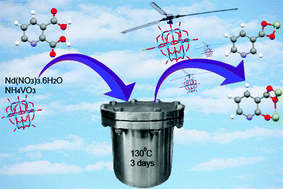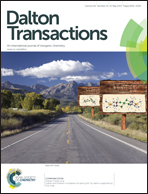Hydrothermal synthesis, X-ray structure and DFT and magnetic studies of a (H2SiW12O40)2− based one-dimensional linear coordination polymer†
Abstract
In this paper, we report the synthesis and characterization of a novel hybrid with an inorganic–organic structure formulated as [[Nd2(L1)2(L2)(H2O)7][H2SiW12O40]]n·4H2O (1), in which HL1 = nicotinic acid and H2L2 = 2-hydroxynicotinic acid. Interestingly, L1 and L2 are generated from an in situ transformation of the original ligand, pyridine-2,3-dicarboxylic acid under hydrothermal conditions. Structural analysis showed that this compound is a one-dimensional linear coordination polymer constructed from a repetition of the Keggin anion as a bidentate bridging ligand and one propeller-like dinuclear neodymium complex. Furthermore, in the packing arrangement, hydrogen bonds and anion–π interactions connect the adjacent chains to extend the structure into a 3D architecture. The magnetic properties of this compound have also been studied by measuring its magnetic susceptibility in the temperature range 1.8–300 K. We also analyzed the coordination ability of the SiW12 Keggin anion in the reported structures up to now. Finally, we have performed a DFT computational study on the noncovalent anion–π interactions between the Keggin anion and the aromatic ligands coordinated to Nd.



 Please wait while we load your content...
Please wait while we load your content...